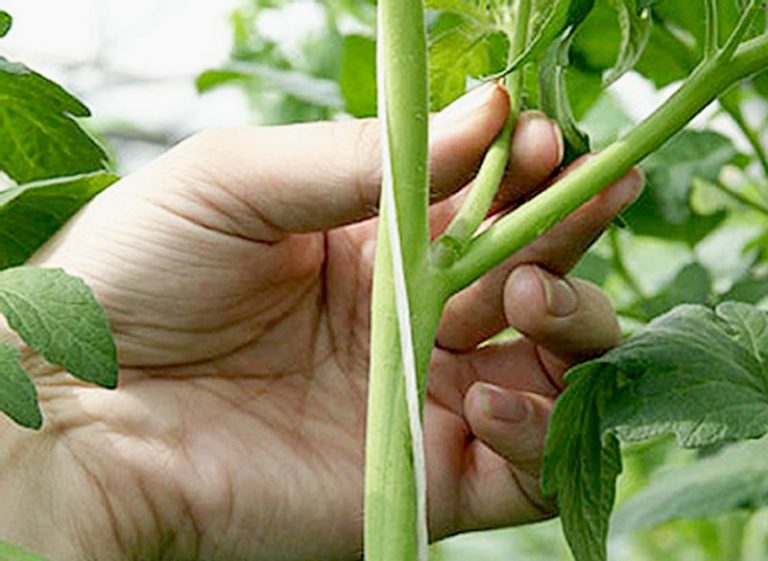 To obtain a high tomato crop, you need to know the agrotechnical methods of growing the crop. Among them is pinching, a mandatory procedure for most varieties and hybrids of tomatoes.
To obtain a high tomato crop, you need to know the agrotechnical methods of growing the crop. Among them is pinching, a mandatory procedure for most varieties and hybrids of tomatoes.
Content
What is pinching and why is it needed
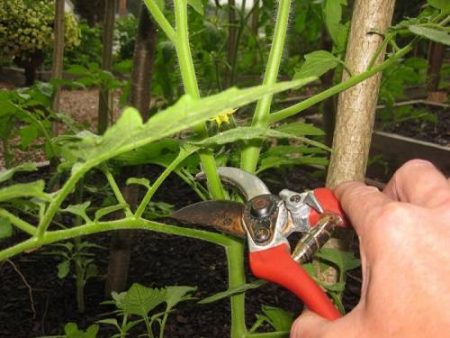 Tomato bushes during the growing season actively increase lateral shoots and leaves. Powerful indeterminate tomatoes, characterized by unlimited growth, branch especially strongly. Such plants are not only tall, but also highly leafy, with many side shoots.
Tomato bushes during the growing season actively increase lateral shoots and leaves. Powerful indeterminate tomatoes, characterized by unlimited growth, branch especially strongly. Such plants are not only tall, but also highly leafy, with many side shoots.
A feature of the culture is the appearance of lateral shoots in the axils of the leaves, and at first the leaf itself grows, and only then a twig appears. The lateral process was called the stepson, and it should be removed.
Pasynkovka - removal (cutting, breaking out) of extra shoots growing in the axils of the leaves. They quickly gain length, require nutrition, moisture, sun, thereby taking all this from fruiting branches.
A tomato bush with overgrown stepchildren resembles a green branching tree, but there is little joy from this. There is an imbalance between fruit brushes and green mass, which ultimately leads to a decrease in yield.
Stepsons grow from each sinus, develop, give new leaves, which also have lateral processes. Development requires nutrients, as a result there is a serious slowdown in the formation and ripening of fruits. The plant cannot give the required amount of nutrition to the tomatoes, as the growing shoots “take” most of it. Not only the quantitative indicators of productivity are reduced, but also the quality of the fruits.
With insufficient nutrition, tomatoes are formed small, for a long time they ripen on the bushes. Unsized indeterminate tomatoes in shelters create real “jungle”, because of which the fruits on the branches lack not only food, but also light.
Experts have found that when removing stepsons, the ripening of tomatoes is accelerated by 12-14 days. For regions with harsh climates and short summers, this is especially important. On the bush there are only “necessary” branches, flower and fruit-bearing brushes, as well as stepsons, used as additional trunks.
Thanks to a simple but responsible procedure, the overall yield increases, the taste of the fruits improves.
Stepson or fruit brush - how to distinguish
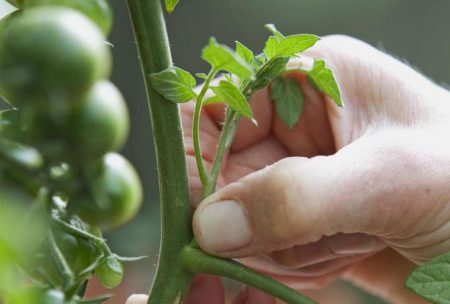 It is difficult for inexperienced summer residents to determine where in the tomato bush stepsons and how not to remove useful fruitful branches instead.
It is difficult for inexperienced summer residents to determine where in the tomato bush stepsons and how not to remove useful fruitful branches instead.
The main differences:
- the stepson always grows from the bosom of the leaf, and the brush - only from the stem of the plant;
- leaves are formed on the stepson, the fruit brush does not have them, and the emerging buds are immediately visible.
When stepsoning, it is recommended to remove lateral shoots that have reached 4-5 cm. At this time, leaflets are clearly visible on stepsons and it is not difficult to distinguish them from fruit brushes.
Step-by-step time
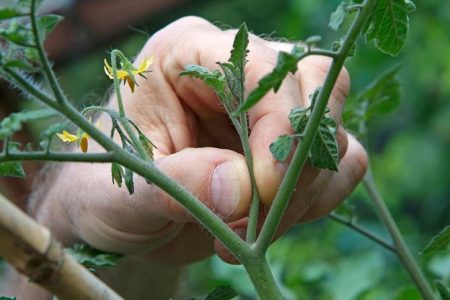 In terms of time, the beginning of the removal of lateral shoots occurs at the time of the appearance of the first brush of tomatoes during its flowering period. In the axils of the leaflets, processes are formed that quickly gain strength, and they should be carefully removed.
In terms of time, the beginning of the removal of lateral shoots occurs at the time of the appearance of the first brush of tomatoes during its flowering period. In the axils of the leaflets, processes are formed that quickly gain strength, and they should be carefully removed.
The best time for pinching is early morning.During the day, the wounds formed on the stem will dry out, they will not get an infection. In the morning, the stems on the tomato bushes are better for breaking out, the plant experiences less stress.
How to stepson?
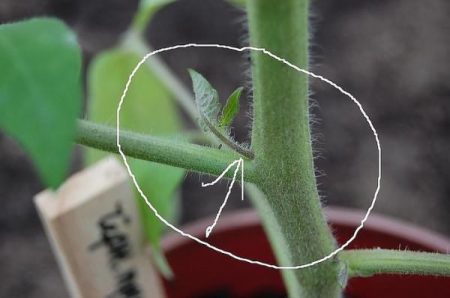 Remove the lateral processes with your hands or with a sharp knife. It is preferable to break out with your hands, but at the same time you need to act carefully, hold the main stem of the plant and prevent peeling from the stem. Pinch the sprout, leaving a “hemp”.
Remove the lateral processes with your hands or with a sharp knife. It is preferable to break out with your hands, but at the same time you need to act carefully, hold the main stem of the plant and prevent peeling from the stem. Pinch the sprout, leaving a “hemp”.
Juice from the wound should not fall into the hands, since with it viruses are transferred to other bushes during pinching (if suddenly the plant is unhealthy). When using tools (scissors, a knife), care must also be taken not to cut off the stem or leaf of a tomato with the stepson, and not to damage the bush. Tools need to be sharpened, cut off the stepson quickly, leaving a “stump” up to 1.5 cm long.
After removing the stepson in the bosom, the knife or scissors are disinfected in a weak solution of potassium permanganate. Disinfection prevents transmission from bush to bush possible infections.
Tomatoes in a greenhouse: bush formation
Any greenhouse has limited space, when planting tomatoes take into account its size (height, width of the structure, the length of the beds) and observe the distance between the holes.
In the descriptions of tomatoes (especially indeterminate varieties), the recommended scheme for planting bushes per square meter is always indicated. Also, most tomatoes in the descriptions have a recommendation for maintaining plants in one, two or more stems.
For greenhouse tomatoes, breaking down stepsons and forming bushes according to a certain pattern is a necessary technique that ensures the development of plants, air access, adequate nutrition, and good lighting. Three main methods of forming bushes are practiced when they leave one “trunk”, two and three.
The choice is explained by the characteristics of the variety or hybrid culture, as well as growing conditions.
1 stem formation
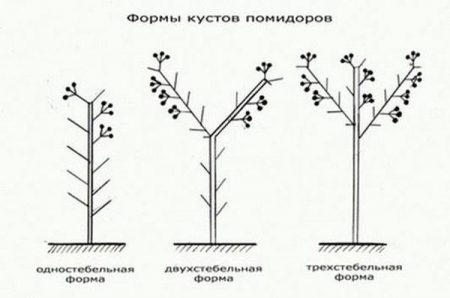 This method is considered the simplest, since you do not need to calculate anything by the number of lateral processes. The main thing is to correctly determine where stepchildren and remove them in a timely manner. In such bushes, fruit brushes are formed only on the central stem, all shoots growing from the sinuses break out.
This method is considered the simplest, since you do not need to calculate anything by the number of lateral processes. The main thing is to correctly determine where stepchildren and remove them in a timely manner. In such bushes, fruit brushes are formed only on the central stem, all shoots growing from the sinuses break out.
First, the stepson is removed under the first inflorescence when buds are formed on it. Usually it grows strong, powerful, but you can not let it outgrow. They break out the shoot until it becomes more than 4-5 cm.
Also remove the leaves below the first brush, but gradually, at one time - 1-2 leaves. By the time the tomatoes ripen on this first fruiting branch on the stem below, all leaves must be removed.
Tomatoes growing in one stalk need a mandatory garter. Trellis is used for this in the greenhouse.
Growing tomatoes in one “trunk” is an option for large polycarbonate shelters with tall varieties requiring a large space, a lot of light and air. When removing excess shoots, ventilation, illumination of plants in the shelter improves, the fruits form and ripen faster.
2 stalk formation
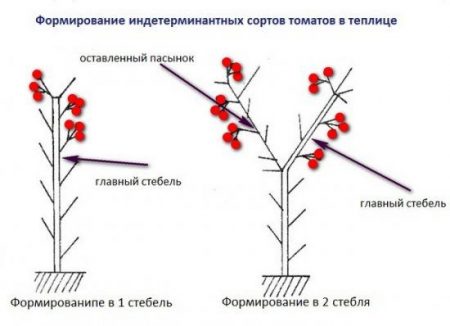 What should I do if a package of seeds with a description of a specific tomato variety contains a recommendation on the formation of a tomato in two stems? Of all the shoots, it is required to leave one, the strongest and most powerful stepson, who will “work” with an additional stem.
What should I do if a package of seeds with a description of a specific tomato variety contains a recommendation on the formation of a tomato in two stems? Of all the shoots, it is required to leave one, the strongest and most powerful stepson, who will “work” with an additional stem.
All other shoots in the axils of the leaves are regularly removed. The bush of tomato with this method of formation is branched, wide, along with the main one, the brushes with fruits are formed on an additional stem.
As the second "trunk", a lateral shoot growing under the first inflorescence is chosen.It grows below the brush, differs in power, thickness, and in many varieties, when growing, the effect of bifurcation of the stem is created.
This method of forming greenhouse tomatoes among gardeners is the most popular, since almost all varieties are suitable for it, with very few exceptions.
3 stalk formation
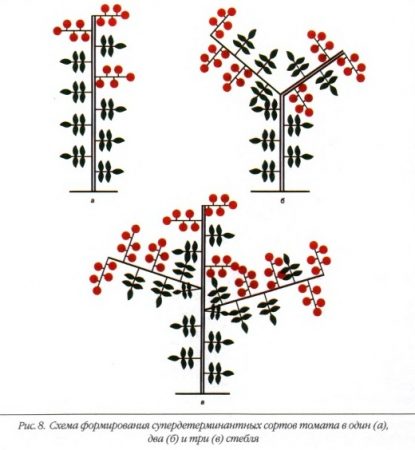 This “three-barreled” variant is similar to the previous method of forming a bush. Along with the main stem, two additional stepson give floral brushes on the bush. When choosing shoots, they leave one stepson under the first inflorescence (as in the formation of two stems), as well as another, growing higher on the stem.
This “three-barreled” variant is similar to the previous method of forming a bush. Along with the main stem, two additional stepson give floral brushes on the bush. When choosing shoots, they leave one stepson under the first inflorescence (as in the formation of two stems), as well as another, growing higher on the stem.
Lateral shoots from the sinuses of other leaves are regularly removed. With this method, bushes are planted less often, observing distances, since plants are distinguished by splendor, a large number of side shoots and flower brushes.
Features of the formation of different varieties of tomatoes
Growing tomatoes, gardeners use different methods of formation, taking into account such a parameter as limited and unlimited growth.
Formation of indeterminate varieties
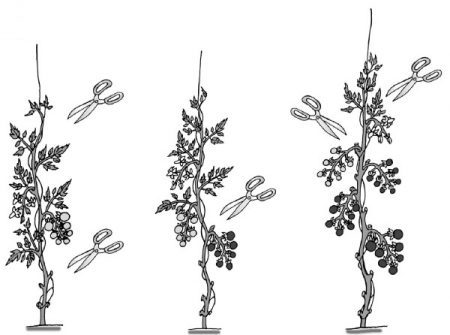 Indeterminate varieties and hybrids of tomatoes are distinguished by their power, unlimited growth, and a large number of regularly growing lateral shoots.
Indeterminate varieties and hybrids of tomatoes are distinguished by their power, unlimited growth, and a large number of regularly growing lateral shoots.
The first brush with inflorescences is formed after about 9-12 leaves, at the same time stepsons begin to grow from the sinuses. Without removing shoots, the bush grows in breadth greatly, flowering and fruit formation slows down, as the green mass takes a large proportion of nutrients.
Therefore, indeterminate varieties are formed with the removal of all stepsons and the leaving of the central trunk. The stalk grows up without restrictions, upon reaching the trellis it is bent and released down. About a month before the end of the growing season, pinch the top of the main stem. Pinch in the middle lane in mid-August, early in the northern regions, in early August. The term is determined not only by climate, but also by the condition of plants, growing conditions. In heated greenhouses, fruiting occurs until November, so pinching is done later.
The formation of semi-determinant varieties
Semi-determinant varieties located in the middle between indeterminate and determinant tomatoes have their own characteristics.
- These are varieties and hybrids of the generative type of growth, prone to the formation of a large number of fruits.
- In plants, there is a reduced distance between the brushes - 12-16 cm, therefore, more flower brushes grow on the stem to the trellis.
- From 8 to 12 inflorescences are formed on the bush, but with insufficient nutrition, half-children unexpectedly stop growing, and then in the absence of a reserve (additional) stepson, the total productivity decreases.
Based on the growth characteristics of semi-determinant varieties, it is recommended to grow them in two or three “trunks”. The options are as follows:
- under the first formed inflorescence leave a stepson, pinch the central trunk after the formation of 5-6 flower brushes on it;
- two additional lateral shoots are left, choosing the strongest ones, the point of growth of the main stem is perfused after the appearance of 4-5 inflorescences on it.
The turning of the central stem makes it possible to direct all the forces to the plant to form ovaries on the hands and ripen the fruit.
At least one additional stepson is left on the bushes of semi-determinant tomatoes to replace the main stem.
Formation of Determinant Varieties
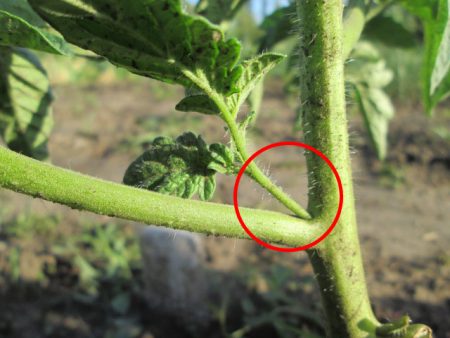 A distinctive feature of the varieties of the determinant type is an independent growth restriction. The bushes are compact, medium and small in height, so the option of plant formation is selected taking into account the variety, weather, growing conditions.
A distinctive feature of the varieties of the determinant type is an independent growth restriction. The bushes are compact, medium and small in height, so the option of plant formation is selected taking into account the variety, weather, growing conditions.
To obtain early harvests and rapid ripening of fruits, a method of growing in one "trunk" is suitable. The total number of fruits from one bush is small, but in the early stages summer residents remove red tomatoes.
When cultivating determinant plants with a central stem, it is recommended to increase the number of bushes per square meter. Plants are arranged in a row, planted up to 6 bushes per 1 square. meter.
When planning to plant children and form them in two “trunks” with leaving one side shoot, you will collect more fruits, but the ripening dates will be later (about 10-14 days). If the stem does not end on its own, pinch it in August.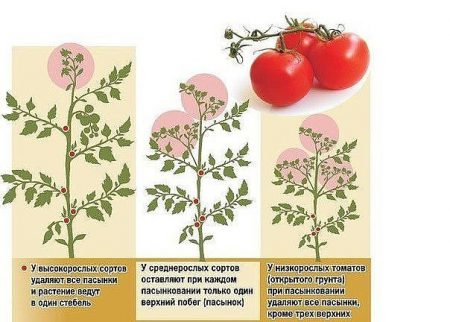
Leaving three “trunks” on the bush, they get the maximum possible, but not early harvest. During the tying and filling of fruits on the brushes of the central stem, two additional stepson with inflorescences grow. They take away part of the nutrients, which is why fruit ripening slows down. But everything is compensated by a large number of tomatoes from the plant, and they ripen after harvesting at home.
Tomatoes grown in open ridges are formed in 1-2 stems. Superdeterminant tomatoes leave one extra stepson, the rest are removed.
Modern undersized hybrids are grown on ridges without pinching, or they remove lateral processes from the axils of the leaves from them until the first inflorescence.
Kizima stepsoning
Gardening enthusiasts creatively approach the cultivation of tomatoes, trying various options for agricultural technology. Famous gardener-experimenter Galina Kizima offers her own way of forming tomatoes.
Its essence is that on stems of limited growth leave two stems, on all the rest - only one. Excess lateral shoots are removed, preventing overgrowing. The leaves under each inflorescence are removed as the fruits ripen. At the end of July, all tomatoes of unlimited growth pinch.
The method provides for a reduction in watering, more suitable for regions with a dry summer. In areas of the North-West, Siberia, where the summer season is unpredictable and often rains, the Kizima method gives lesser results.
Pasynkovka when growing tomatoes - an important technique that allows you to increase the total harvest of fruits from the bush, improve the taste of ripe tomatoes.




 Low-growing tomatoes, without pinching: 5 of the most delicious varieties
Low-growing tomatoes, without pinching: 5 of the most delicious varieties Why tomato seedlings grow poorly
Why tomato seedlings grow poorly We grow a tomato in a shell
We grow a tomato in a shell Growing tomatoes without watering according to the method of Kazarin
Growing tomatoes without watering according to the method of Kazarin